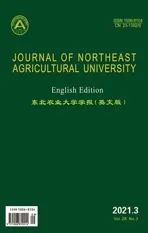Effects of Plant Protein Hydrolysate on Emergence and Growth of Rice Seedlings
2021-10-21TaoBoZhengCaiyueLiJingjingGuoJingandZhangYuhang
Tao Bo, Zheng Cai-yue, Li Jing-jing, Guo Jing, and Zhang Yu-hang
College of Agriculture, Northeast Agricultural University, Harbin 150030, China
Abstract: With the rise of organic agriculture, researches on the production of slow-release organic fertilizer from natural organic materials have attracted much attention.Plant protein and peptides have potential applications in agricultural production.The effects of bioactive peptides derived from plant protein on rice seed germination and seedling growth and development were systematically studied using bioassays and greenhouse growth experiments.The feasibility of phytoprotein peptide application in the rice seedling stage was discussed.The results showed that the phytoprotein peptides had no adverse effects on rice, and the application when applied to rice seedlings, phytoprotein peptides within a certain concentration range produced obvious promotion effects on the growth and development of rice seedlings, which were more pronounced in the underground part of the plants.Phytoprotein peptides increased root length and dry matter accumulation and improved the robustness of rice seedlings.A 40 g·mol-1·L-1 dose of phytoprotein peptides increased root length, plant fresh weight, plant dry weight, root fresh weight and root dry weight by 59.24%, 20.14%, 26.32%, 51.57% and 81.70%, respectively compared to the control.In addition, the phytoprotein peptides significantly increased the chlorophyll content, root activity and nitrate reductase activity of rice seedlings, as well as superoxide dismutase, peroxidase, catalase and β-1, 3-glucanase activity in rice leaves, which could improve stress resistance.Plant peptides were simple to produce and costeffective.Reasonable development and excavation of plant protein and protein hydrolysate peptide in China's agricultural application had a good practical basis and value significance.
Key words: phytoprotein peptides, rice, emergence, growth and development
Introduction
Rice is one of the main grain crops around the world.From the distribution of all the continents, Asia is the main producer and marketing area of rice.Approximately 90% of rice production and 87% of rice sales are conducted in Asia (Rahman and Zhang, 2018).Global rice consumption is steadily growing and reached 703 million tons in 2019.Rice consumption in Asia, Europe, North America, South America and Africa accounts for 45.1%, 18.7%, 18.6% 7.4% and 7.4% of the world's total, respectively and China is the world's largest producer and seller of rice (Shanet al., 2020).The growth conditions and seedling quality at the seedling stage are important factors that directly affect rice growth, development and yield.Sufficient growing conditions in the early developmental stages are essential for disease resistance throughout the growth period, improvement of rice quality and assurance of high yield, including fertile soil matrix and sufficient nutrients (Huanget al., 2014).However, in rice-producing areas around the world, problems of low seedling emergence rate, poor seedling quality, lodging and disease are the main factors that limit rice yield.Therefore, strengthening the research on rice seedling quality is still an important aspect of rice cultivation (Bai and Yin, 2017).The popularization and application of rice seedling-strengthening agents, chemical fertilizers and plant growth regulators can improve the quality of rice seedlings; however, long-term and large-scale use can reduce soil quality, destroy the soil structure and pollute the surrounding environment through volatilization, leaching and runoff of these compounds (Chenget al., 2015).Therefore, the development of organic biological agents that can improve the emergence rate, stress resistance and quality of rice seedlings without harming the soil and the surrounding environment is crucial to achieve high quality, high yield and sustainable rice production.
Phytoprotein peptides that can regulate the physiological functions of organisms (Zhanget al., 2010; Caoet al., 2016).Peptides have potential applications in agricultural production.Compared with proteins, bioactive peptides not only have better absorption performance but also affect physiological functions, such as the promotion of immunity and hormone regulation, and possess antibacterial and antiviral properties (Xue, 2014).The use of cheap plant proteins to develop high value-added biologically active peptide products has increasingly attracted attention.Enzymatic hydrolysis is a widely used technique for protein and peptide production due to its high efficiency, ability to maintain nutritional value and lack of a peculiar smell.Earlier studies have demonstrated that soybean meal and other plant proteins and hydrolytic peptides can improve the nitrate reductase activity and photosynthetic capacity ofZoysia japonica(Bingaman and Christians, 1995; Yang, 2008).In addition, the application of plant protein powder and dipeptides on broad-leaved tobacco and strawberry plants provide a rich source of natural nitrogen fertilizer for mature plants (Nonnecke and Christians, 1993; Unruhet al., 1997).At present, high-protein natural raw plant material is mainly used in the production and processing of animal feed for livestock, poultry and pets as well as lawn fertilizers.Few agricultural applications of plant proteins have been researched (Xue, 2014).However, there are almost no reports on utilization for production of food crops such as rice, wheat and corn.The development and utilization of plant protein and peptides in crop production can reduce environmental pollution, save resources, and fully tap the potential value of the plant protein industry.Therefore phytoprotein peptide research has far-reaching significance in the agricultural field.The purpose of this study was to analyze the effects of plant protein hydrolysate on rice seed emergence, seedling growth and physiological characteristics, and to investigate the feasibility of plant protein and hydrolysate peptide applications in agricultural production.
Materials and Methods
Test materials
Longjing 43 rice variety was provided by the Rice Research Institute, Agricultural College of Northeast Agricultural University, Harbin, China.Plant protein powder was purchased from Shandong Luzhou Food Co., Ltd.(Shandong, China) and alkaline protease was purchased from Beijing Aobo Star Biotechnology Co., Ltd (Beijing, China).
Preparation of phytoprotein peptides
Phytoprotein peptides were prepared according to the method of Yang and Lu (2010).Plant protein particles were crushed using a high-speed pulverizer, passed through a 150-mesh sieve, and further crushed using a super airflow pulverizer.After passing through a 300-mesh sieve, 20 g of protein powder was weighed and added to a 250 mL conical flask.The volume was adjusted to 100 mL with distilled water, 7% alkaline protease was added, and pH was adjusted to 8.The mixture was placed in a constant temperature water bath oscillator (150 r·min-1) for 6 h at 46℃.After the reaction, the mixture was placed in a 100℃ water bath for 10 min for inactivation.The mixture was cooled and then centrifuged at 5 000 r·min-1for 10 min.The supernatant was then filtered through two layers of filter paper to remove the impurities floating on the surface of the supernatant.The obtained solution was the plant protein peptide solution.
Determination of phytoprotein peptide effects on rice emergence
Rice seeds were sterilized with 5% NaClO for about 10 min, washed with distilled water, then clean filter paper was used to absorb the remaining water until the seed surfaces were dry.Next, the rice seeds were soaked in water for 48 h and placed into a net bag.Five layers of wet gauze were wrapped outside the net bag.The net bag was washed every day and the gauze was kept moist.After more than 85% of the rice seeds germinated, 100 rice seeds in the same germination state were selected and evenly planted in a rice seedling tray and covered with soil.The phytoprotein peptide concentrations were set at 0, 15, 30, 40, 60 and 90 g·mol-1·L-1, and the spraying volume was 50 mL·m-2.After spraying, the seedling tray was placed in a constant temperature incubator.The culture conditions were as the followings: day and night temperature was (25±0.5)℃/(18±0.5)℃ and light (2 500 lx) wasLD=12 h/12 h.Each treatment was repeated three times.The rice seedling emergence rate was calculated every day for 7 days using the following equation.
Emergence rate=seedling number/sowing number× 100%
Determination of phytoprotein peptide effects on growth and physiological characteristics of rice seedlings
The experiment was conducted in the greenhouse of Zhendao Organic Farm in Yanjiagang, Heilongjiang Province, in 2018 and 2019, and the test results were integrated and analyzed.The same rice seed disinfection method was used as described above.Each seedling tray (30 cm × 70 cm) was evenly seeded with 100 grains of rice seeds and covered with soil.Phytoprotein peptide doses of 0, 15, 30, 40, 60 and 90 g·mol-1·L−1were sprayed evenly on the trays, and the injection volume was 50 mL·m-2.Each treatment was repeated three times.The plant height and root length, plant fresh weight and dry weight, and root fresh weight and dry weight were measured when the third leaf appeared.The chlorophyll content, root activity, soluble protein, superoxide dismutase (SOD), catalase (CAT) and peroxidase (POD) activity in the rice leaves were measured from the 20th day after sowing.At the same time,β-1, 3-glucosaminidase (β-1, 3-glu) and nitrate reductase activity in the rice leaves were also measured.The samples were collected every two days for a total of five times.
Root activity
The TTC (2, 3, 5-Triphenyltetrazolium chloride) reduction method (Zou, 2000) was used to determine root activity.Briefly, 0.2 mL of 0.4% TTC solution was added into a volumetric flask.Then, a small amount of Na2S2O2powder was added and used to make up the volume with ethyl acetate.To 0.25, 0.50, 1.00, 1.50 and 2.00 mL of the solution, added ethyl acetate to a volume to 10 mL.The corresponding OD485values of the solutions were measured at OD485, corresponding to different concentrations of TTF (1, 3, 5-Triphenylformazane), and the standard curve was constructed.Each sample root (0.5 g) was placed in a small beaker and 5 mL of 0.4% TTC solution and 5 mL of phosphate buffer was added, mixed and soaked thoroughly.The mixture was kept it dark at 37℃ for 1 h.Then, 2 mL of 1 mol·L-1sulfuric acid solution was added to terminate the reaction.The blank solution was prepared by adding 0.5 g of root into a small beaker and 2 mL of 1 mol·L-1sulfuric acid solution was added at the same time.The roots of the test and blank groups were removed after the reaction, followed by drying the reaction solution.The residue was put into a mortar and 5-6 mL of acetoacetate and quartz sand was added to grind the mixture to obtain the full extract TTF.The residue was washed with acetoacetate and then simultaneously fixed the volume of the extraction solution to 10 mL and mixed well.The corresponding OD485value of each treatment was determined and the reduction amount of TTC was calculated using the standard curve.TTC reduction intensity was used as root activity.
TTCreduction intensity (µg·g-1·h-1) =TTFreduction amount (µg) × (gt)-1
g, root weight;t, reaction time.
Chlorophyll content
Chlorophyll content was measured using the ethanol–acetone immersion method described previously (Tian, 2007).Approximately, 0.2 g leaves were added in a mortar, followed by the addition of 1 mL of 95% ethanol to grind them.The mixture was thoroughly grinded and transferred into a 5 mL centrifuge tube.Then, 2 mL of 95% ethanol was added to wash the solution.The solution was poured into a centrifuge tube and centrifuged them at 5 000 r·min-1for 10 min.One milliliter of the supernatant was transferred into a 10 mL centrifuge tube, to which 9 mL of 95% ethanol was added.The absorbance values were measured at 665, 649 and 470 nm after mixing, with 95% ethanol as the blank control.The results were as the followings:

Chlorophyll content (mg·g-1) = (CT×V× dilution ratio)/(W× 1 000)
Ca, chlorophyll a concentration;Cb, chlorophyll b concentration;CT, total chlorophyll concentration;V, extract volume;W, fresh weight
Enzyme activity
The fresh seedling leaves (0.15 g) of each treatment sample were taken and ground into a homogenate using 4 mL of 0.05 mmol·L-1pH 7.8 phosphate buffer (PBS) on ice.The supernatant was used to determine antioxidant enzyme activity after centrifugation at 4℃ for 15 min at 10 000 r·min-1.
SOD activity was determined by preparing 2.9 mL of the reaction solution containing 50 mmol·L-1PBS, 100 µmol·L-1riboflavin, 750 µmol·L-1Nitroblue tetrazolium (NBT), 130 mmol·L-1methionine, and 0.1% EDTA-Na2.Then, 100 µL of the crude enzyme extract was added.The solution was exposed to 4 000 lx light for 15 min, and the absorbance was determined at 560 nm.As a control, 2.9 mL of NBT reaction solution, 100 µL of 0.05 mmol·L-1pH 7.8 PBS extraction buffer was used.The amount of enzyme required for photoreduction of 50% NBT was defined as one unit (U) (Pinheroet al., 1997).
SOD activity (U·g-1FW)=[(ODcontrol−ODtest)/ODcontrol] × (100/50) × dilution ratio/W
ODcontrol, control tube absorbance; ODtest, absorbance of sample tube; dilution ratio, volume of extraction solution/volume of reaction solution; W, fresh weight.
Peroxidase (POD) activity was determined by adding 100 µL of the enzyme solution, 2 700 µL of 25 mmol·L-1pH 7.0 PBS (containing 2 mmol·L-1ethylene diamine tetraacetic acid (EDTA), 25℃), 100 µL of 1.5% guaiacol (V/V), and 100 µL of 300 mmol·L-1H2O2in a 3 mL reaction system.After shaking, the solution was quickly transferred to a cuvette, and the wavelength was set at 470 nm, with monitoring time of 1 min (Guanet al., 2009).
POD activity (nmol·g-1·FW·min-1)=[C× (A×V)/a]/ (E×W),E= 26.6 mmol·L-1·cm-1
C, activity measurement value;A, the total volume of the reaction solution;V, the total extraction solution;a, extraction solution for determination;W, sample weight.
Catalase (CAT) activity was determined by preparing 3 mL of the reaction system containing 100 µL of the enzyme solution, 2 800 µL of 25 mmol·L-1pH 7.0 PBS (containing 2 mmol·L-1EDTA, 25℃),100 µL of 300 mmol·L-1H2O2.After shaking, it was quickly transferred into a colorimetric dish.The wavelength was set at 240 nm and the monitoring time was 2 min (Raoet al., 1996).
CAT activity (nmol H2O2·g−1FW·min−1)=[C×(A×V)/a]/(E×W),E=39.4 mmol·L-1·cm-1
C, activity measurement value;A, the total volume of the reaction solution;V, the total extraction solution;a, extraction solution for determination;W, sample weight.
Nitrate reductase (NR) activity was determined by adding 0.4 mL of the crude enzyme solution into a 10-mL test tube.Then, 1.2 mL of 0.1 mol·L-1KNO3PBS and 0.4 mL of NADH solution was added, mixed well and kept the solution in a 25℃ water bath for 30 min.In the control group, NADH solution was not added, but 0.4 mL of 0.1 mol·L-1pH 7.5 PBS was added.After heat preservation, 1 mL of sulfonamide solution was immediately added to terminate the enzyme reaction.Then, 1 mL of naphthyl vinylamine solution was added, followed by incubation for 15 min for color development.The solution was centrifuged for 5 min at 4 000 r·min-1; the supernatant was used to measure the absorbance at 540 nm.The total amount of nitrite nitrogen (µg) in the reaction solution was calculated as the followings (Tang and Luo, 2012):
NRactivity (µg × g−1× h−1) =V1C/V2WT
C, the total amount of nitrous nitrogen produced by the reaction liquid;V1, volume of the mixed solution added, when extracting the enzyme solution;V2, volume of the crude enzyme solution added during the enzyme reaction;W, fresh weight of the sample;T, reaction time.
β-1, 3-glucanase (β-1, 3-glu) activity was determined by adding 0.5 mL of 0.04% laminarin (Sigma) substrate solution to 0.5 mL of the above crude enzyme extract and reacting the solution in a water bath at 50℃ for 10 min.Then, 1 mL of DNS was added, mixed well and incubated in a boiling water bath for 5 min.The solution was cooled to room temperature and the optical density was measured at 540 nm.The enzyme solution was heated to inactivate the enzyme protein and was used as the control.According to the optical density value of the extracted solution, the corresponding glucose content (µg) was obtained based on a standard curve.The activity unit ofβ-1, 3-glucanase was defined as the amount of enzyme producing 1 µg glucose per minute at 50℃, which was a unit of enzyme activity, namely µg·mL-1·min-1(Tian, 2007).
β-1, 3-glu activity (µg·mL-1·min-1)=(S×D×1 000)/Vt
S, the amount of glucose corresponding to the measured light absorption;D, the dilution ratio of enzyme solution;V, the amount of enzyme solution;t, reaction time.
Data analysis
Test data were taken as the average of three repetitions and Microsoft Excel 2003 was used for data processing and preliminary analysis.The Data Processing System (DPS7.05) software was used to analyze the data.The Duncan's new complex range method was used for determining the difference in significance.The Duncan's new complex range method was used to detect significant differences among the means at a level ofp≤0.05.
Results
Effect of phytoprotein peptides on rice emergence rate
The application of phytoprotein peptides had no adverse effects on rice seed emergence.From the third day, the emergence rate of rice seeds in the phytoprotein peptide treatment groups was significantly higher than that in the control group.On the sixth day, the emergence rate was 88.33%, 92.67%, 96.33%, 97.00%, 91.33% and 87.67% for 0, 15, 30, 40, 60 and 90 g·mol-1·L-1treatment, respectively.Excessive concentrations of the treatment had a certain inhibitory effect on the germination rate.As shown in Table 1, the phytoprotein peptides promoted uniform rice seedling emergence, when the dosage was below 60 g·mol-1·L-1.
Effects of phytoprotein peptides on growth, development, and physiological characteristics of rice seedlings
Effects of phytoprotein peptides on rice seedling morphological indices
In general, the growth status of rice seedlings treated with phytoprotein peptides was significantly better than that of the control (Table 2).Compared with the control, fresh and dry weight, root length, and root fresh and dry weight were significantly higher in all the phytoprotein peptide treatments.When the dosage was 40 g·mol-1·L-1, the plant height, root length, plant fresh weight, plant dry weight, root fresh weight and root dry weight increased by −9.76%, 59.24%, 20.14%, 26.32%, 51.57% and 81.70%, respectively compared to the control treatment.The phytoprotein peptide treatments promoted the accumulation of dry matter in the above ground and below ground parts of rice seedlings; the growth promotion effect was more pronounced in the roots.

Table 1 Effect of phytoprotein peptides on seed emergence rate of rice seeds

Table 2 Effects of phytoprotein peptides on morphological indices of rice seedlings
Effects of phytoprotein peptides on rice seedling chlorophyll content
Rice seedling chlorophyll content was significantly increased in all the phytoprotein peptide treatments compared to the control (Fig.1).The chlorophyll content was the highest in the 40 g·mol-1·L-1treatment, which was 24.55% higher than that of the control.It could be seen from Fig.1 that the chlorophyll content of plant protein hydrolysate treatment for 1-10 days was significantly higher than that of the control, and the difference was the largest on the fourth day, which was 51.28% higher than that of the control.
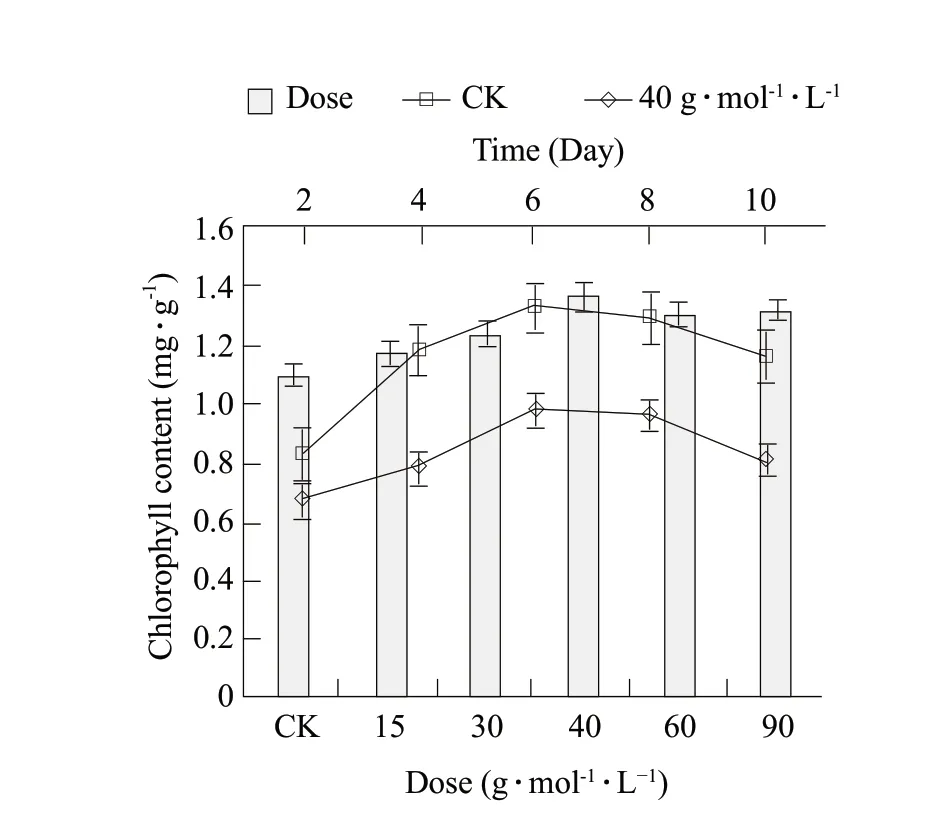
Fig.1 Effect of different doses and time of phytoprotein peptides on chlorophyll content in rice leaves
Effects of phytoprotein peptides on rice seedling root activity
Rice seedling root activity was significantly increased in all the phytoprotein peptide treatments compared to the control (Fig.2).When the dosage was 15, 30, 40, 60 and 90 g·mol-1·L-1, the root activity increased by 10.01%, 23.76%, 51.26%, 21.26% and 23.76%, respectively.The root activity was the highest in the 40 g·mol-1·L-1treatment.After treatment with 40 g·mol-1·L-1phytoprotein peptides, the root vigor of rice seedlings increased rapidly, stabilizing on the sixth day.The root activity was significantly higher than that of the control throughout the experiment (days 1-10) and the difference was the largest (74.57%) on the 10th day.

Fig.2 Effect of different doses and time of phytoprotein peptides on root activity of rice
Effects of phytoprotein peptides on rice seedlingsuperoxide dismutase activity
Rice seedling SOD activity was significantly increased in all the phytoprotein peptide treatments compared to the control (Fig.3).When the dosage was 15, 30, 40, 60 and 90 g·mol-1·L-1, the SOD activity increased by 4.30%, 9.68%, 23.66%, 25.81% and 27.96%, respectively compared to the control.SOD activity increased gradually with the increases in phytoprotein peptide concentration.After treatment with 40 g·mol-1·L-1phytoprotein peptides, SOD activity was significantly higher than that of the control throughout the experiment.The difference was most pronounced on the sixth day, when the difference between the two groups was 23.38%.
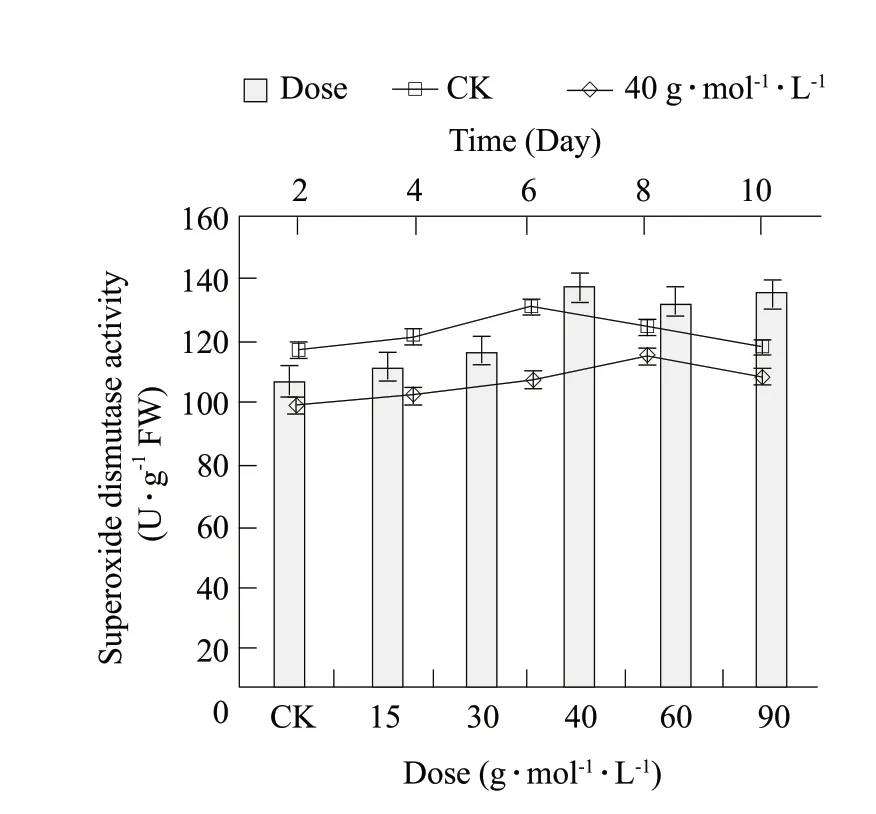
Fig.3 Effects of different doses and time of phytoprotein peptides on superoxide dismutase activity in rice leaves
Effects of phytoprotein peptides on rice seedling peroxidase activity
Rice seedling POD activity was significantly increased in all the phytoprotein peptide treatments compared to the control (Fig.4).When the dosage was 15, 30, 40, 60 and 90 g·mol-1·L-1, POD activity increased by 17.91%, 32.83%, 47.76%, 49.25% and 37.31%, respectively compared to the control.When the dosage was lower than 60 g·mol-1·L-1, POD activity increased with the increase in concentration (Fig.4).POD activity was highest in the 60 mL·m-2phytoprotein peptide treatment, which was 49.25% higher than that of the control.After treatment with 40 g·mol-1·L-1phytoprotein peptides, POD activity was significantly higher than that of the control throughout the experiment.The difference between the two groups was most pronounced on the sixth day at 47.22%.
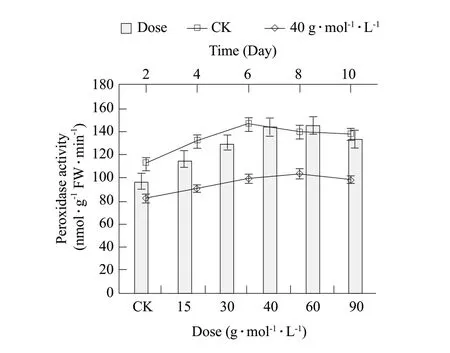
Fig.4 Effects of different doses and time of phytoprotein peptides on peroxidase activity in rice leaves
Effects of phytoprotein peptides on rice seedling catalase activity
Rice seedling CAT activity was significantly increased in all the phytoprotein peptide treatments compared to the control (Fig.5).When the dosage was 15, 30, 40, 60 and 90 g·mol-1·L-1, CAT activity increased by 12.29%, 30.09%, 52.00%, 28.72% and 23.25%, respectively compared to the control.CAT activity increased with the phytoprotein peptide dosage up to 40 g·mol-1·L-1.In the 40 mL·m-2phytoprotein peptide treatment, CAT activity was significantly higher than that of the control throughout the experiment, and the difference was the largest on the sixth day.

Fig.5 Effects of different doses and time of phytoprotein peptide on catalase activity in rice leaves
Effects of phytoprotein peptides on rice seedling NR activity
Rice seedling NR activity was significantly increased in all the phytoprotein peptide treatments compared to the control (Fig.6).NR activity increased with the phytoprotein peptide dosage up to 40 mg·mL-1.When the dosage of phytoprotein peptides was 40 g·mol-1·L-1, NR activity was the highest, which was 73.16% higher than that of the treatment, NR activity was significantly higher than that of the control throughout the experiment, reaching the peak on the eighth day.The difference between the two groups was most pronounced on the 10th day at 94.99%.
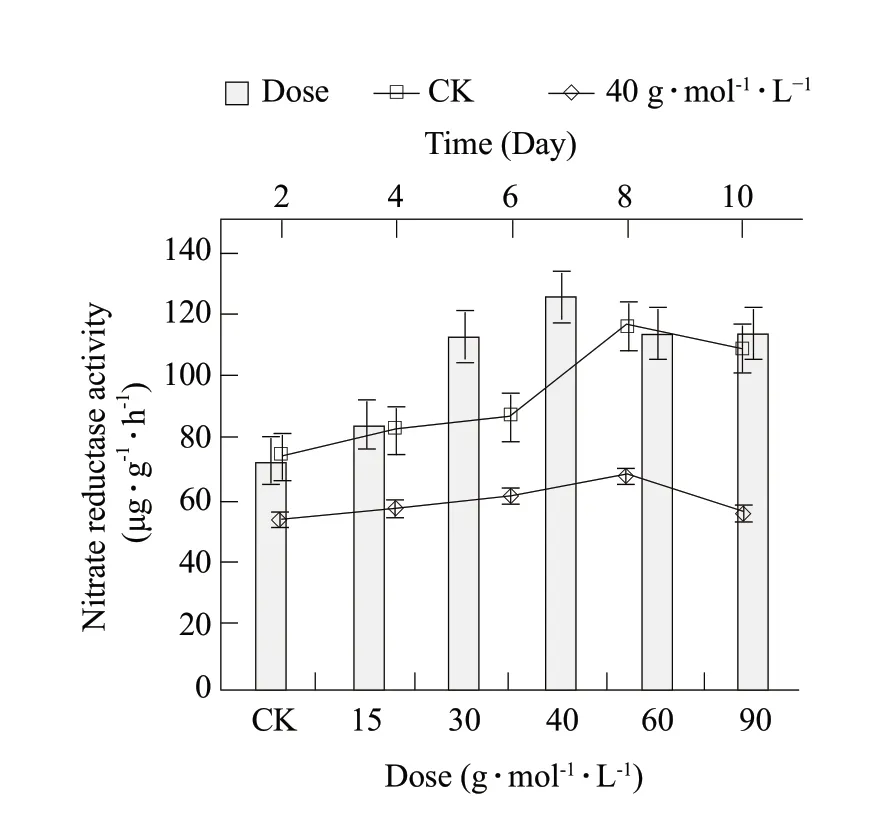
Fig.6 Effects of different doses and time of phytoprotein peptides on nitrate reductase activity in rice leaves
Effects of phytoprotein peptides on rice seedling β-1, 3-glucanase activity
Rice seedlingβ-1, 3-glucanase activity was significantly increased in all the phytoprotein peptide treatments compared to the control (Fig.7).The activity ofβ-1, 3-glucanase in rice leaves increased in a dose-dependent manner, reaching a maximum at 45 g·mol-1·L-1.When the dosage was 15, 30, 40, 60 and 90 g·mol-1·L-1the activity ofβ-1, 3-glucanase increased by 17.65%, 30.51%, 39.71%, 69.12% and 122.43%, respectively compared to the control.In the 40 g·mol-1·L-1phytoprotein peptide treatment, theβ-1, 3-glucanase activity was significantly higher than that of the control throughout the experiment, reaching the peak on the sixhth day.The difference between the two groups was most pronounced on the sixth day at 43.33%.

Fig.7 Effects of different doses and time of phytoprotein peptides on β-1, 3-glucanase activity in rice leaves
Discussion
Peptides were molecular polymers that consisted of short chains of amino acids.Physiologically, peptides shareed characteristics with protein and amino acid, but had a stronger absorption mechanism (Donget al., 2004).Phytoprotein peptides were rich in amino acids, and possessed several desirable characteristics, such as good solubility, low viscosity, strong fluidity and good thermal stability, making them a highly valuable available resource.At present, the application of phytoprotein peptides was mainly concentrated in the forage industry to promote the growth of edible fungi.Microbial protein peptides, plant protein peptides, animal protein peptides and rice dregs were used as nitrogen sources or nutritional additives for fungi cultivation.The results showed that several protein peptides had a promoting effect on the growth of oyster mushrooms (Niet al., 2010).Animal protein peptides, such as earthworm hydrolysate could significantly promote tomato growth, increase tomato leaf area, plant height, root tip number, stem and leaf dry weight, improve tomato quality, enhance antioxidant capacity and increase tomato yield (Zhanget al.,2020).With the rise of organic agriculture, research on the production of slow-release organic fertilizer from natural organic materials has attracted much attention (Surekhaet al., 2010).Compared with animal protein, plant protein had wide range of materials, was inexpensive, and the technology required for processing and production was relatively simple.The plant protein powder used in this study contained as much as 50% protein as well as carbohydrates, fat, fiber, ash and lutein.It could be found that phytoprotein peptides obtained by enzymatic hydrolysis were more effective on the growth and development of crops than the plant protein powder itself.The results showed that phytoprotein peptides could improve the uniformity of rice seed emergence, improve the robustness of rice seedlings, promote the growth of rice seedlings including root growth and dry matter accumulation, and prevent the phenomenon of excessive growth in the later stage of seedling development.Healthy plant root systems could provide the necessary nutrients, directly affecting the growth status of the aboveground plant parts and crop yield.The robustness of the root system could be used as an index to measure the growth and development of plants (Liu, 2006).In this study, it could be found that low- to mid-range doses of phytoprotein peptides could improve the root activity and robustness of rice seedlings to a great extent, but the application of higher doses (more than 60 g·mol-1·L-1) had inhibitory effects on seed germination and plant height.Because the hydrolysates prepared in this experiment were mainly peptide mixtures with different molecular weights, whether this high-dose inhibition was caused by the allelopathy of specific peptides and the toxicity of ammonia produced by hydrolysate in the process of soil decomposition to a certain extent or just due to the stress of nitrogen on plants remains to be further analyzed.
Plants possess effective immune systems (Asaiet al., 2002), which could be stimulated with exogenous substances for agricultural purposes, inducing broadspectrum disease resistance and stress resistance, regulating the metabolic system, promoting plant growth.Exposure to stress could increase the production of reactive oxygen species (ROS) and cause oxidative damage to plants.The metabolism of ROS was crucial for the growth, development, adaptation and survival of crops under pressure (Hasanuzzamanet al.,2020).Excessive ROS accumulation could destroy proteins, membranes, DNA and RNA in plants.In addition, oxidative stress might result in cell wall damage and increase cell membrane permeability, resulting in plant physiological metabolism disorder, yellowing of the leaves, root damage and finally plant death (Caverzanet al., 2016).Under normal conditions, ROS production and corresponding scavenging processes in plants were in a dynamic balanced state (Kao, 2017).Increases in antioxidant enzyme activity promoted the production of antioxidant substances to reduce ROS damage to cells (Choudhuryet al., 2017; Mittler, 2002).SOD, POD and CAT were the key enzymes of biological defense system established in the process of biological evolution, which could effectively scavenging free radicals and peroxides in plants.Its activity was the main parameter to characterize the stress resistance of plants (Boret al., 2003).β-1, 3-glucanase was widely involved in plant growth and development and various disease and stress resistance responses (Balasubramanianet al., 2012).At the same time,β-1, 3-glucanase was also the key enzyme of cellulose biosynthesis, and cellulose played a key role in stem lodging resistance (Kokuboet al., 1991).Nitrate reductase (NR) was an inducible enzyme.As the most important rate-limiting enzyme in nitrogen metabolism, its activity affected the synthesis of amino acids and proteins and the conversion of ammonium nitrogen (Guet al.,2018; Gaoet al., 2009), These enzymes played a synergistic role in plant life activities, affecting plant metabolism and the synthesis and transformation of many important substances.The results showed that applying phytoprotein peptides to the seedbed of rice seedlings significantly increased SOD, POD, CAT andβ-1, 3-glu activity, which could improve the ability of rice seedlings to resist adverse environments.The chlorophyll content and NR activity were also significantly increased by the phytoprotein peptides treatments.On the one hand, it might be that the ammonia nitrogen produced by the hydrolysis of plant protein stimulated the defense mechanism of rice seedlings and promoted the activity of antioxidant enzymes, promote the enhancement of nitrogen metabolism, and then promoted the activity of various physiological indexes of rice seedlings.On the other hand, it might be that some peptides produced by the hydrolysis itself had antioxidant activity, which improved the stability of the cell membrane of rice seedlings and improved the activities of various antistress enzymes and metabolic enzymes.
Plant protein powder is one of the main byproducts in crop plant processing.It was of great importance to develop and utilize the existing and potential protein resources, to improve the sustainability and profitability of agricultural production (Yang and Lu, 2010).The experimental results show that phytoprotein peptides could promote rice growth and improve the quality of seedlings as well as enhance stress resistance by increasing antioxidant enzyme activity.Phytoprotein peptides would have good application potential and market value for the production of rice and other crops in the future, but the role, effective storage time and metabolic mechanism of peptides on rice should be further explored.In addition, for broader application value and promotion prospects in agricultural production, phytoprotein peptides could be processed or compounded with inorganic N, P, K and other nutrient elements to form a biological fertilizer for rice seedling and other crops.
Conclusions
Plant proteins and peptides had potential applications in agricultural production.This study showed that low- to mid-range doses of phytoprotein peptides could improve the uniformity of rice seed emergence and the robustness and growth of rice seedlings, including root growth and dry matter accumulation, and prevented the phenomenon of excessive growth in the later stage of seedling development.But the application of higher doses (more than 60 g·mol-1·L-1) had inhibitory effects on seed germination and plant height.In addition, phytoprotein peptides significantly increased antioxidant enzyme activity, chlorophyll content and nitrate reductase levels.A 40 g·mol-1·L-1dose of phytoprotein peptides increased chlorophyll content, root activity, superoxide dismutase, peroxidase, catalase and nitrate reductase activity by 24.55%, 51.26%, 23.66%, 47.76%, 52.00% and 73.16%, respectively compared to the control.When the dosage was 90 g·mol-1·L-1the activity ofβ-1, 3-glucanase increased by 122.43%, plant peptides were simple to produce and cost-effective.It was feasible to develop and utilize in agriculture.It had a broad application prospect in pollution-free organic agriculture.
杂志排行
Journal of Northeast Agricultural University(English Edition)的其它文章
- Water Consumption Processes of Different Planting Models in Rice Production of Northeast China
- Optimum Combination Test of Erosion Gully in Black Soil Regions by Coal Gangue Reconstruction Soil
- Effect of Chilling Stress on Synthesis of Antioxidant Enzymes, Osmotic Adjustment Substances and Membrane Lipid Peroxide Levels in Two White Clover Cultivars
- Complete Genome Sequencing and Analysis of Rehmannia Mosaic Virus Isolate from Shanxi Province
- Reversal Effects of Ivermectin and Moxidectin on Multidrug Resistance in C6/adr Cells in vitro
- Effects of DHRS3 in C2C12 Myoblast Differentiation and Mouse Skeletal Muscle Injury
